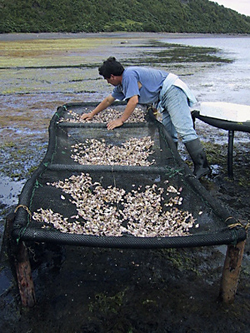RCA News


RCA News
View
| IAEA Concerns Heavy Environmental and Economic Effects of Red Tide Encourage Adopting Nuclear Techniques to Evaluate Safety Hazards | |||
|---|---|---|---|
|
Name
admin |
Date
2005.03.15 |
Views
4677 |
|

The IAEA's report highlighted how people around the world are fighting 'red tape' in their search for solutions. The report introduced a story from a fishing town on the west coast of Luzon, the Philippines, explaining how the government and the nuclear research institutes are jointly stepping in the efforts to combat against the seafood threatening incidence.
(Source: IAEA)
Some algal blooms are laden with a toxin that can concentrate in mussels, clams, and other shellfish and be lethal to cosumers. Scientists call these varieties HABs (Harmful Algal Blooms). One health condition they can cause is paralytic shellfish poisoning (PSP), characterized by death from respiratory arrest. The problem is that the toxic algal blooms causing PSA have been on a rapid rise, perhaps because of the growth of coastal aquaculture over the many decades.
What is important is to provide the most accurate evaluation of any safety hazards in the seafood products that have assumed attack by the red tide. The early and accurate determination will both help the fishers and the consumers. Conventionally, 'live mouse bioassay' method has been employed for the test. This method is still prevailing throughout the Asia-Pacific region, even though its level of specificity in toxin determination is mediocre at best. Since 1997, an IAEA TC project has been working in the Philippines (PNRI) to transfer a more scientifically advanced and precise method - the receptor binding assay technology using a tritium labeled saxitoxin. Currently, it is known as the very best way to ensure the evaluation of any safety hazards in seafood products.
PNRI and UPMSI (Marine Science Institute of University of the Philippines) have been making excellent progress in adopting the new method, and are already providing backup testing and analysis for the conventional laboratories operated by BFAR (Bureau of Fisheries and Aquatic Resources). It is expected that within a few years, the nuclear techniques will assume the lead role in ensuring safety for the public.
For more information, please visit to www.iaea.org
Attachments




